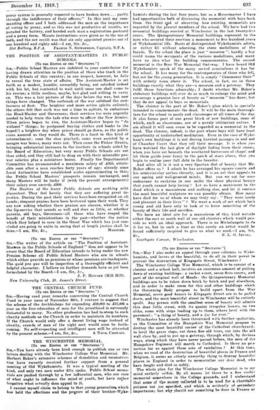THE WINCHESTER MEMORIAL.
(To THE Maros or THE "Srecraroa.") Sie,—You have already been kind enough to publish one or two letters dealing with the Winchester College War Memorial. Mr. Herbert Baker's extensive schemes of demolition and reconstruc- tion have recently received further support from a general meeting of Old Wykehamists. It was a typical meeting of the kind, and only two men under fifty spoke. Public School memo- rials are pushed through by a few influential men, who are sure of what ought to influence the mind of youth, but have rather forgotten what actually does appeal to it.
I cannot myself claim to belong to that young generatiosa which has held the affections and the preiyers of their brother-Wyke-
•
hamists during the last four years, but as a Housemaster I have had opportunities both of discussing the memorial with boys back from the front ILO of observing how existing memorials are regarded by the present members of the school. We have had two memorial buildings erected at Winchester in the last twenty-five. years. The Quingentenary "Memorial buildings represent to the men who secured their erection a monument to five hundred years of Wykehamical life. Busts of distinguished Wykehamists adorn. or rather fill without adorning, the stone medallions of the façade. To the school the place is just "museum "; hardly a boy could name the occupants of the various medallions, and many have no idea what the building commemorates. The second memorial is the Boer War Memorial Gateway. I have heard Old Wykehamists speak of the many sacred associations it has for the school. It has many for the contemporaries of those who fell. but not for the young generation. It is simply "Commoner Gate " with orderly room above it. The school, in feet, see in these buildings exactly what they are—a museum and a gateway. They fulfil those functions admirably; I doubt whether Mr. Baker's elaborate buildings will ever do as much to enlarge the mind and encourage a genuine love of beauty as " museum " has done; but they do not appeal to boys as memorials.
The cloister is the part of Mr. Baker's plan which is specially intended to commemorate the dead. It will be the main thorough- fare for the school to meals and classrooms at all times of the day. It also forms part of one great block of new buildings, some of which, such as classrooms, are of a purely utilitarian nature. I am afraid it will soon cease to be regarded as a memorial to the dead. The cloister, indeed, is the part where boys will have least opportunity of undisturbed meditation. Even in the case of Wyke- ham's own buildings it is not during hurried passages in and out of Chamber Court that they tell their message. It is when yin have watched the last glow of daylight fading from their stones., when you have sat beneath the weathered buttresses of chapel and let them guide your fancy to the patch of stars above, that you begin to realize your full debt to the founder.
And after all is it not a very Spartan diet of beauty that Mr. Baker offers us ? I admit he has arranged his square courts and his semi-circular arches cleverly, and it is an art that appeals te our ageing and well-grooved minds. But can we not for once endeavour to enshrine in our midst the sheer physical beauty that youth cannot help loving ? Let us have a monument to the dead which is a mausoleum and nothing else, and let it contain the most beautiful sculpture we can possibly obtain. How, many have died for us of whom we may truly say : "They were lovely and pleasant in their lives" ? We want a work of art which both young and old have only to look at to know something of the beauty of their life and sacrifice.
We have an ideal site for a mausoleum of this kind outside either the east or south wall of our old cloisters which would pro- vide us with an ideal approach. There is no Michelangelo to tie it for us, •bat in such a time as this surely an artist would be found sufficiently inspired to give us what we need.—I am, Sir. IL L. G. IRVING. Southgate Corner, Winchester.






































 Previous page
Previous page